

The Complete Guide To The 5 Types Of Organizational Structures For The Future Of Work. Finding the Job of Your Life - Gianpiero Petriglieri. Let’s face it.

We all think about it. At times we think of little else — even if only rarely and in certain settings do we feel free to admit it. The conversation often begins furtively, the question murmured as if slightly shameful or out of place. How can I get more of it at work? Meaning, that is. Meaning at work, in work, from work. It may be because we are freer. It may be because we are too focused or not focused enough. It may be because we are more exposed. Someone always seems to be pulling it off. The more we reach for meaning, the more elusive it becomes. When you look at it that way, meaning is like love. Yearning for either turns some into poets and drives the rest of us on a quest to experience it. But when it comes to love, most grown-ups realize what that quest will take. We long ago gave up the fantasy that a Prince or Princess Charming will show up one day to sweep us off our feet. Love, the sentiment, is a consequence of having found our somebody.
Dating. How social technologies are extending the organization - McKinsey Quarterly - High Tech - Strategy & Analysis. Companies are improving their mastery of social technologies, using them to enhance operations and exploit new market opportunities—key findings of our fifth annual survey on these tools and technologies, in which we asked more than 4,200 global executives how organizations deploy them and the benefits they confer.

When adopted at scale across an emerging type of networked enterprise and integrated into the work processes of employees, social technologies can boost a company’s financial performance and market share, respondents say, confirming last year’s survey results. But this is a very dynamic environment, where the gains from using social technologies sometimes do not persist, perhaps because it takes so much effort to achieve them at scale.
Some companies, respondents indicate, reaped fewer benefits and thus became less networked, while a smaller percentage learned how to deploy these technologies to become even more networked. Usage at scale and continued benefits Looking ahead.
System Thinking. A Brief History of the Corporation: 1600 to 2100. On 8 June, a Scottish banker named Alexander Fordyce shorted the collapsing Company’s shares in the London markets.

But a momentary bounce-back in the stock ruined his plans, and he skipped town leaving £550,000 in debt. Much of this was owed to the Ayr Bank, which imploded. In less than three weeks, another 30 banks collapsed across Europe, bringing trade to a standstill. On July 15, the directors of the Company applied to the Bank of England for a £400,000 loan. Two weeks later, they wanted another £300,000. If this sounds eerily familiar, it shouldn’t. In its 400+ year history, the corporation has achieved extraordinary things, cutting around-the-world travel time from years to less than a day, putting a computer on every desk, a toilet in every home (nearly) and a cellphone within reach of every human. So it is a sort of grim privilege for the generations living today to watch the slow demise of such a spectacularly effective intellectual construct.
Arthur C. Reach versus Power II.